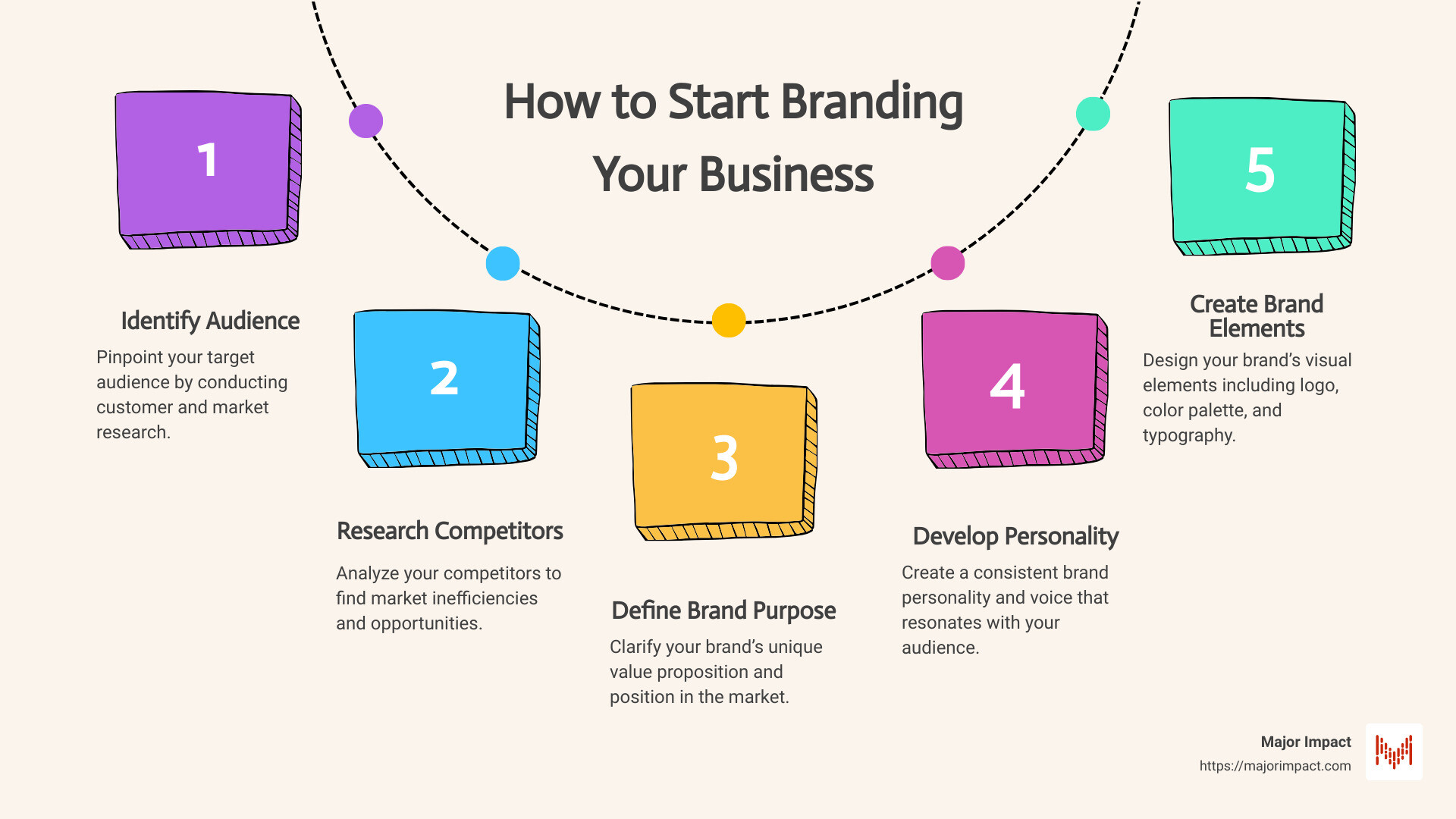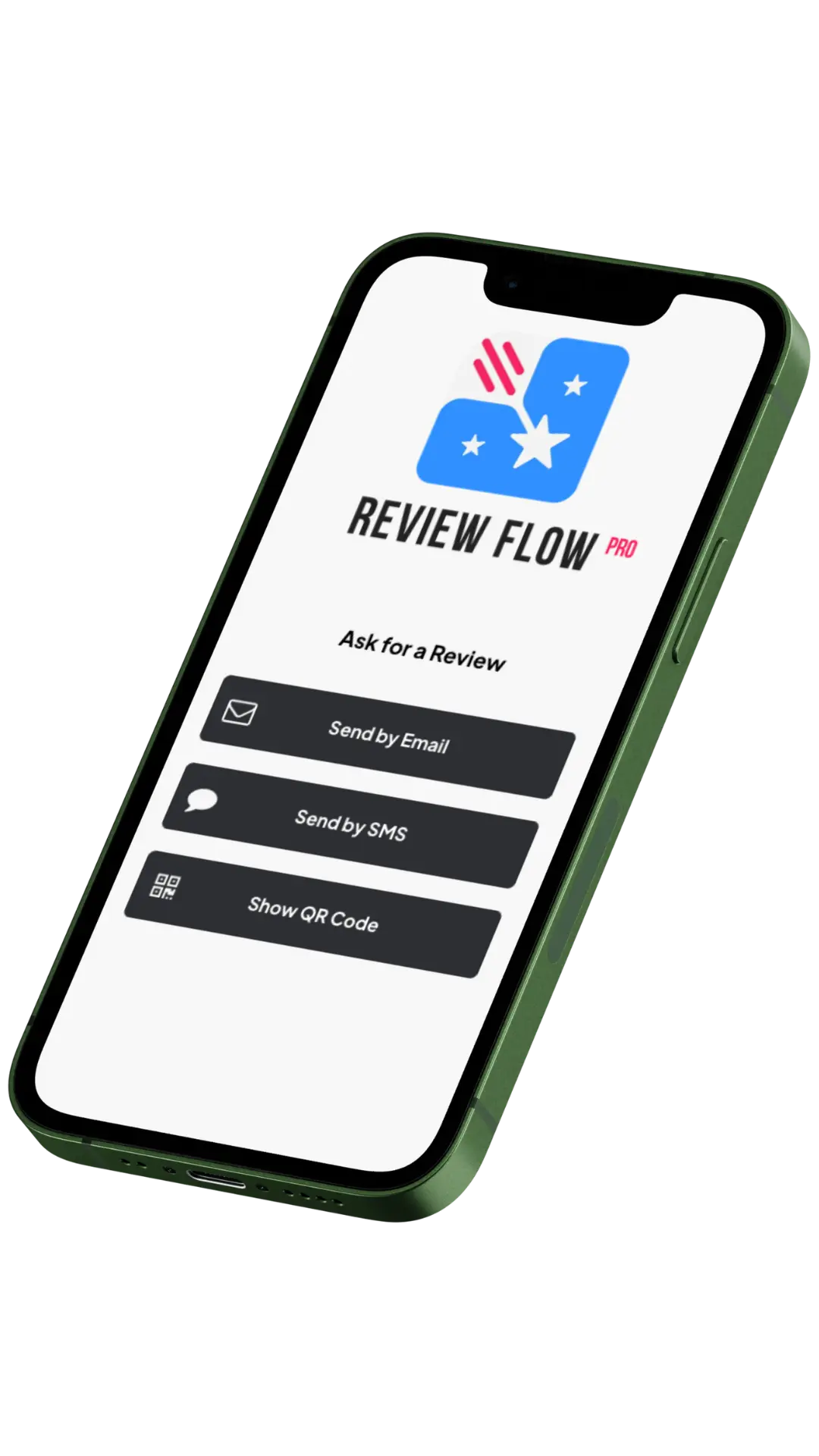Table of Contents
How to start branding your business may seem overwhelming at first, but breaking it into simple steps can make the journey more manageable. Here’s a quick guide to get you started:
- Identify Your Audience
- Research Your Competitors
- Define Your Brand’s Purpose and Position
- Develop a Personality and Brand Voice
- Create Your Brand Story
- Choose a Brand Name and Slogan
- Design Your Brand Look and Logo
- Integrate Your Brand into Your Business
Building a strong brand is not just about having a logo or catchy slogan. It involves creating a cohesive image that resonates with your target audience. This includes your brand identity, strategy, and marketing tactics.
Brand Identity: This is how you want to be seen by your audience. It includes your logo, colors, and overall visual style. It’s about consistency in every interaction customers have with your business.
Brand Strategy: This is your game plan. It outlines how you will convey your brand to your audience. This involves setting goals, understanding your market, and planning your messaging.
Brand Marketing: This is how you take your brand to the public. It involves using social media, online advertising, content marketing, and more to make sure your brand is seen and remembered.
About Me
I’m Elliott Kosmicki, and I’ve spent over 20 years helping small businesses master how to start branding your business. From my early days in Los Angeles to leading marketing departments, I’ve seen how a strong brand can set a business apart.
Next, we’ll explore understanding your business to lay a solid foundation for your brand.
Understanding Your Business
Before you can effectively brand your business, you need to understand it inside out. This involves defining your company identity, values, conducting a SWOT analysis, and crafting a mission statement.
Company Identity
Your company identity is the essence of your business. It’s not just your logo or name; it’s what your business stands for. Think of it as the personality of your company. Ask yourself:
- What do we do?
- Why do we do it?
- How do we do it?
For example, Nike is not just a sportswear company. Its identity revolves around innovation and inspiration for athletes.
Values
Your values are the principles that guide your business. They shape your company culture and influence how you interact with customers.
Key Tip: Choose values that are authentic and reflect what your company truly stands for. Generic values like “integrity” or “quality” are not enough. Be specific.
Example: Core Systems values providing the best service throughout the design and engineering process, setting them apart from competitors.
SWOT Analysis
A SWOT analysis helps you understand your business’s Strengths, Weaknesses, Opportunities, and Threats. This tool is crucial for finding the best branding approach and avoiding pitfalls.
- Strengths: What does your business do well?
- Weaknesses: Where can you improve?
- Opportunities: What advantages do you have over competitors?
- Threats: What challenges could hinder your success?
Example: A local bakery might find that its strength is using organic ingredients, its weakness is limited seating, its opportunity is a growing interest in healthy eating, and its threat is a new bakery opening nearby.
Mission Statement
Your mission statement is a concise declaration of your business’s purpose and goals. It should answer:
- Why does your company exist?
- What problem can your product or service solve?
- Why should customers choose you over a competitor?
Example: Nike’s mission statement is “To bring inspiration and innovation to every athlete.” This simple yet powerful statement guides all of Nike’s activities from product design to marketing.
By understanding your business through these lenses, you lay a solid foundation for effective branding. Next, we’ll dive into identifying your audience to better tailor your brand strategy.
Identifying Your Audience
Understanding your target audience is crucial for successful branding. This involves creating buyer personas, conducting customer research, and performing market research. Here’s how to get started:
Create Buyer Personas
A buyer persona is a fictional representation of your ideal customer. It includes details such as age, location, income, and interests. For instance, if you are selling eco-friendly products, your buyer persona might be a 30-year-old urban professional who values sustainability.
Key Elements of a Buyer Persona:
- Demographics: Age, gender, income, education.
- Psychographics: Interests, values, lifestyle.
- Behavioral Traits: Buying habits, product use cases, brand affinities.
Example: A skincare brand might create a persona named “Eco Emily,” a 25-year-old living in a big city, earning $50,000 a year, and passionate about organic products.
Conduct Customer Research
Customer research helps you understand the needs, preferences, and pain points of your target audience. Use surveys, interviews, and social media interactions to gather insights.
Methods of Customer Research:
- Surveys: Online or in-person questionnaires.
- Interviews: One-on-one conversations with customers.
- Social Media Listening: Monitoring social media platforms for mentions and feedback.
Case Study: A local bakery used surveys to find that their customers wanted more gluten-free options. This feedback helped them expand their product line and attract a new customer segment.
Perform Market Research
Market research involves analyzing your industry and competitors to identify opportunities and threats. This helps you position your brand uniquely in the market.
Steps in Market Research:
- Identify Competitors: List direct and indirect competitors.
- Analyze Competitors: Examine their strengths, weaknesses, pricing, and customer reviews.
- Find Market Gaps: Look for underserved areas or unmet customer needs.
Example: A new coffee shop might find that competitors lack vegan options. By offering a variety of vegan choices, they can attract a niche audience.
Tools and Techniques
Use various tools to streamline your research process. Keyword research tools like Ahrefs or SEMrush can help you understand what topics your audience is interested in and what your competitors are missing.
Recommended Tools:
- Google Analytics: For website traffic and user behavior insights.
- SurveyMonkey: For creating and distributing surveys.
- Ahrefs/SEMrush: For keyword and competitor analysis.
Pro Tip: Combine data from multiple sources to get a comprehensive view of your audience. This will help you create more targeted and effective branding strategies.
By identifying your audience through buyer personas, customer research, and market research, you can tailor your branding efforts to meet their needs and preferences. Next, we’ll explore how to research your competitors to further refine your brand strategy.
Researching Your Competitors
To build a successful brand, understanding your competitors is crucial. This involves competitor analysis, identifying market inefficiencies, and employing strong SEO practices. Let’s break it down.
Competitor Analysis
Start by identifying your main competitors. Look at their:
- Products and Services: What do they offer?
- Pricing: How do they price their products?
- Marketing Strategies: What channels do they use? What kind of content do they produce?
- Customer Reviews: What do their customers say about them?
Create a spreadsheet to track these details. This will help you see where your brand stands and identify areas for improvement.
Case Study: A local bakery noticed their competitors lacked a strong online presence. By focusing on SEO and social media, they captured a larger market share.
Market Inefficiencies
Look for gaps or weaknesses in the market. These could be:
- Underserved Niches: Are there customer needs that aren’t being met?
- Product Gaps: Is there a product or service your competitors don’t offer?
- Customer Pain Points: What are customers complaining about in reviews?
By capitalizing on these inefficiencies, you can carve out a unique niche for your brand.
Example: Casper disrupted the mattress industry by simplifying the buying process and focusing on online sales, an area where traditional brands were lagging.
SEO Practices
Good SEO can drive organic traffic to your website. Study your competitors’ SEO strategies:
- Keywords: What keywords are they targeting? Use tools like Ahrefs or SEMrush to find out.
- Content: What type of content do they produce? Blogs, videos, infographics?
- Backlinks: Where are they getting their backlinks from?
Tip: Consistent, strategic SEO can lead to strong brand equity, much like how Coca-Cola commands higher prices due to its brand power.
Keyword Research Tools
Effective keyword research can give you an edge. Tools like:
- Google Keyword Planner: Free and easy to use.
- Ahrefs/SEMrush: More advanced options for in-depth analysis.
- Ubersuggest: Great for finding long-tail keywords.
These tools help you find keywords your competitors aren’t targeting, giving you a chance to rank higher in search results.
Pro Tip: Use a mix of short-tail and long-tail keywords to capture a wider audience.
By conducting thorough competitor research, you can identify strengths to match and weaknesses to exploit. This will help you develop a more effective and differentiated brand strategy.
Next, we’ll dig into defining your brand’s purpose and position to further refine your branding efforts.
Defining Your Brand’s Purpose and Position
Your brand’s purpose and position are the foundation of your business identity. They help you connect with your audience and stand out from competitors. Let’s break it down:
Brand Purpose
Your brand purpose answers the big “why” behind your business. Why do you exist? What problem are you solving? For instance, Nike exists to bring inspiration and innovation to every athlete. This purpose guides all their activities, from product design to marketing.
Steps to Define Your Brand Purpose:
- Identify Your Core Values: What principles guide your business?
- Understand Your Impact: How do you make a difference in your customers’ lives?
- Communicate Clearly: Make sure your purpose is easy to understand and remember.
Mission Statement
A mission statement is a concise way to communicate your brand’s purpose and goals. It should align with your core values and resonate with your target audience.
Example: Nike’s mission statement is “To bring inspiration and innovation to every athlete in the world.”
Steps to Craft a Mission Statement:
- Define Your Goals: What do you want to achieve?
- Know Your Audience: Who are you serving?
- Keep It Short and Sweet: Aim for a clear and concise statement.
Unique Value Proposition (UVP)
Your UVP explains why customers should choose you over competitors. It highlights what makes your product or service unique and valuable.
Example: Nike’s UVP focuses on high-quality, innovative athletic wear that inspires athletes to perform their best.
Steps to Create a UVP:
- Identify Your Strengths: What do you do better than anyone else?
- Understand Customer Needs: What problems are you solving?
- Be Specific: Clearly state the unique benefits you offer.
Pro Tip: Use customer feedback to refine your UVP. Listen to what your customers value most about your product or service.
By defining your brand’s purpose, mission statement, and UVP, you create a strong foundation for your brand. This clarity will guide all your branding efforts and help you connect more deeply with your audience.
Next, we’ll explore how to develop your brand personality and voice to make your brand even more distinctive.
Developing Your Brand Personality and Voice
Your brand personality and voice are crucial for making your business stand out. They shape how customers perceive and interact with you. Think of your brand as a person. What kind of traits would it have? How would it speak?
Brand Personality
Your brand personality is the set of human characteristics associated with your brand. It helps customers relate to you on a personal level. Here are five basic brand personalities to consider:
- Excitement: Adventurous and spirited.
- Sincerity: Honest and genuine.
- Ruggedness: Tough and outdoorsy.
- Competence: Reliable and intelligent.
- Sophistication: Neat and prestigious.
Example: Harley-Davidson embodies ruggedness. Their tone is adventurous and tough, appealing to those who see themselves as rebels.
Brand Voice
Your brand voice is how you communicate with your audience. It’s the tone and style you use in all your messaging. Consistency is key. Your voice should be the same across all platforms—social media, emails, website, and even face-to-face interactions.
Example: If your brand targets Gen Z, you might use casual language and slang. But if you’re targeting professionals, a formal and polished tone would be better.
Editorial Style Guide
An editorial style guide ensures your brand voice is consistent. It outlines how you should write and speak. Include guidelines on:
- Tone: Formal or informal?
- Language: Any specific words to use or avoid?
- Grammar and Punctuation: Oxford comma, yes or no?
Example: Imagine your brand as a person. If it’s Harley-Davidson, it would speak ruggedly and confidently. It wouldn’t use soft, flowery language.
Case Study: Harley-Davidson
Harley-Davidson’s rugged, adventurous tone is a big part of its brand identity. They use strong, confident language in all their communications. This consistency helps customers identify with their brand and feel part of a community.
Quote: “Live your legend” is a tagline that perfectly captures Harley-Davidson’s brand personality.
By developing a strong brand personality and voice, you make your brand memorable and relatable. This helps build a loyal customer base that feels connected to your brand.
Next, we’ll explore how to create a compelling brand story to further engage your audience.
Creating Your Brand Story
Stories connect people on a personal level. They make your brand relatable and memorable. Let’s explore how you can create a compelling brand story for your business.
The Building a StoryBrand Framework
Donald Miller’s book Building a StoryBrand provides a simple and effective formula for creating a brand story. It starts with a character — your customer — who faces a problem. They meet a guide (your brand) who gives them a plan and a call to action to help avoid failure.
Here’s a breakdown:
- Hero (Your Customer): Give a face to your customer. Create buyer personas to help them relate to your brand.
- Conflict: Highlight what your customer wants or needs. Appeal to their emotions and practical needs.
- Guide: Show why your brand is the solution. Use client testimonials to highlight your brand’s unique value.
- Climax: Describe potential negative impacts if they don’t choose your solution. Then, deliver your call to action.
- Resolution: Promise how choosing your brand leads to success. List several promises your customer can rely on.
Case Study: Burt’s Bees
Burt’s Bees introduces their story right on the search results page. They assume the customer has a skin care problem but also wants to avoid harsh chemicals. Burt’s Bees offers the perfect solution — natural products.
Why Storytelling Works
Storytelling makes your brand human. It explains why your brand exists and what it believes in. Once you have a compelling story, incorporate it into your ads and landing pages.
Example: A local bakery can share stories about their baking process, their commitment to quality, and how they source ingredients locally. This creates an emotional connection with customers.
Crafting Your Brand Story
Use this template to get started:
“We offer [PRODUCT/SERVICE] for [TARGET MARKET] to [VALUE PROPOSITION]. Unlike [THE COMPETITION], we [KEY DIFFERENTIATOR].”
Example: “We offer lightweight and waterproof daypacks for travelers, which fold into a wallet-sized pouch when not in use. Unlike other accessory brands, we guarantee our packs for life — no questions asked.”
Tip: Expand on your positioning statement to include your brand promise and values.
Practical Tips
- Be Authentic: Share real stories and experiences.
- Keep It Simple: Avoid jargon and complex language.
- Be Consistent: Your story should align with your brand voice and personality.
By creating a compelling brand story, you can engage your audience on a deeper level. This leads to stronger customer relationships and brand loyalty.
Next, we’ll explore how to choose a memorable brand name and slogan.
Choosing a Brand Name and Slogan
Choosing a brand name and slogan is one of the most important steps in how to start branding your business. A good name and slogan can make your business memorable and set you apart from competitors like Nike, Adidas, and Facebook.
Brand Name
Your brand name should be short, easy to pronounce, and memorable. Here are some tips to help you choose a great name:
- Made-Up Words: Brands like Adidas use made-up words that are unique and easy to remember.
- Inspirational Figures: Nike is named after the Greek goddess of victory, adding a layer of meaning and inspiration.
- Relevant Words or Phrases: Mastercard clearly indicates its function in the financial sector.
- Word Combinations: Facebook combines two common words to create a unique name.
- Altered Words: Tumblr is a playful twist on the word “tumble.”
Tip: Before settling on a name, do a quick Google search to make sure it’s not already taken. You don’t want to compete with a similar brand name.
Slogan
A strong slogan is brief yet descriptive. It should fit seamlessly into your brand’s overall message and be easy to remember. Here are some approaches to crafting a catchy slogan:
- Use a Metaphor: Skittles uses “Taste the rainbow” to describe their colorful and flavorful candy.
- Capture an Attitude: Toyota’s “Let’s go places” captures the adventurous spirit of their brand.
- Describe What You Do: Home Depot’s “How doers get more done” clearly states their mission.
- Highlight Your Benefits: Rothy’s “Reduce your carbon footprint in style” targets eco-conscious buyers.
- Create a Catchy Rhyme or Saying: Bounty’s “The quicker picker upper” uses rhyme to emphasize its absorbency.
Example: Wendy’s has changed their slogan several times. Their famous “Where’s the beef?” was a huge success, while “Give a little nibble” didn’t resonate as well. This shows the importance of testing and adapting your slogan.
Practical Tips
- Be Consistent: Make sure your slogan aligns with your brand voice and personality.
- Test and Adapt: See which slogans resonate with your audience and be ready to tweak them.
- Keep It Simple: A good slogan is easy to remember and understand.
By choosing a memorable brand name and slogan, you can create a strong foundation for your brand. This will help you stand out and connect with your audience.
Next, we’ll look at how to design your brand’s look and logo.
Designing Your Brand Look and Logo
Designing your brand’s look and logo is a crucial step in building a recognizable and memorable brand. This involves creating a brand logo, selecting a color palette, choosing the right typography, and integrating appropriate imagery. Let’s break down each element.
Brand Logo
Your logo is often the first thing people notice about your brand. Think of iconic logos like Target, Apple, and Nike. They are simple yet memorable.
- Target: A red bullseye that’s instantly recognizable.
- Apple: A sleek apple silhouette with a bite taken out.
- Nike: The famous swoosh that conveys motion and speed.
Tips for a Great Logo:
– Simplicity: Keep it simple. A cluttered logo can be hard to recognize.
– Versatility: Make sure it looks good in various sizes and formats.
– Timelessness: Avoid trends that might make your logo look outdated quickly.
Color Palette
Colors evoke emotions and can influence how people perceive your brand. For example, warm colors like red and yellow can evoke excitement and energy, while cool colors like blue and green can convey calmness and trust.
Tips for Choosing Colors:
– Limit Your Palette: Stick to one or two main colors with a few accent colors.
– Contrast and Legibility: Ensure text is readable over your chosen colors.
– Cultural Relevance: Be aware of cultural meanings associated with colors.
Typography
Fonts play a big role in your brand’s personality. Whether you choose a classic serif font or a modern sans serif font, make sure it aligns with your brand identity.
Tips for Selecting Fonts:
– Two-Font Rule: Use one font for headings and another for body text.
– Readability: Ensure your fonts are easy to read on all devices.
– Consistency: Use the same fonts across all your marketing materials.
Imagery
Imagery includes photos, graphics, and icons that represent your brand. It’s important to maintain a consistent visual style.
Tips for Using Imagery:
– Consistent Style: Use a consistent style for all images, whether they are photos or graphics.
– Quality: High-quality images make your brand look professional.
– Relevance: Ensure images align with your brand’s message and values.
Case Studies: Target, Apple, and Nike
Target: Their logo and color palette are simple but effective. The red bullseye is instantly recognizable, and the use of red creates a sense of urgency.
Apple: Apple’s logo is sleek and modern, reflecting their brand ethos of simplicity and innovation. Their use of minimalistic design extends to their color palette and typography.
Nike: Nike’s swoosh logo is one of the most recognizable logos worldwide. It’s simple, dynamic, and conveys the brand’s focus on athleticism and excellence. Their color palette is usually black and white, which keeps the focus on the products.
Conclusion
Designing your brand’s look and logo is a foundational step in creating a strong brand identity. A well-designed logo, thoughtful color palette, appropriate typography, and consistent imagery can make your brand instantly recognizable and memorable.
Integrating Your Brand into Your Business
Once you’ve established the foundation of your brand, integrate it cohesively throughout your company. This ensures that your brand’s personality and message are consistent across all channels.
Create a Style Guide
A style guide is your brand’s rulebook. It outlines how your brand should look, sound, and feel. This includes everything from your logo and color palette to your brand voice and tone. The goal is to make sure everyone, from your in-house team to freelancers, is on the same page.
Key Elements of a Style Guide:
- Logo Usage: How and where to use your logo.
- Color Palette: Specific colors that represent your brand.
- Typography: Fonts and text styles to use.
- Brand Voice and Tone: How you speak to your audience.
Why is this important? Consistency is key. The more consistent your brand is, the more memorable it becomes. If your brand feels chaotic or disorganized, people will be less likely to remember it.
Warby Parker: A Case Study
Take Warby Parker as an example. They have created a customer-centric brand focused on engaging experiences both online and in-store. Their style guide is evident in everything they do, from their home try-on boxes to the organization of their products on shelves.
Warby Parker’s brand voice is straightforward and mission-driven, using plain language to communicate benefits. This consistent messaging ensures customers have a similar experience, regardless of the platform.
Implementing Your Style Guide
Your style guide should be a living document that evolves with your brand. Make sure to:
- Distribute it: Share it with everyone involved in your marketing efforts.
- Update it: Keep it current with any brand changes.
- Enforce it: Ensure adherence by everyone in your organization.
Consistent Brand Experience
Every touchpoint with your brand should feel cohesive. This includes:
- Social Media: Posts should reflect your brand’s voice and style.
- Marketing Campaigns: Ads should use your brand’s colors, fonts, and messaging.
- Website: Your site should be a seamless extension of your brand.
Next, let’s explore Why You Shouldn’t Be Afraid to Rebrand.
Don’t Be Afraid to Rebrand
Rebranding can be a powerful tool to breathe new life into your business. It’s not just about changing your logo or name; it’s about evolving your brand to better connect with your audience and stay relevant in a changing market.
Why Rebrand?
Rebranding can help you:
- Attract New Customers: A fresh look can appeal to a different demographic.
- Stay Relevant: Adapt to market trends and consumer preferences.
- Correct Missteps: Fix any negative perceptions about your brand.
Listen to Customer Feedback
Customer feedback is crucial when considering a rebrand. Your loyal customers know your brand well and can provide valuable insights. Here are some ways to gather feedback:
- Surveys: Ask your customers what they like and dislike about your current brand.
- Focus Groups: Get in-depth opinions from a small group of customers.
- Online Reviews: Monitor platforms like Yelp and Google Reviews for recurring themes.
Case Study: Dunkin’
A great example of a successful rebrand is Dunkin’. Known as Dunkin’ Donuts for nearly 70 years, the company shortened its name to Dunkin’ in 2019. This change followed a decade of using the slogan “America runs on Dunkin’,” allowing the brand to gauge audience reaction.
The rebrand paid off. Dunkin’ was sold at a valuation of $106.50 per share in 2020, a 50% increase in just two years. This shows how a well-planned rebrand can create new opportunities and drive business growth.
Steps to Rebrand
- Assess Your Current Brand: Understand what’s working and what’s not. Use customer feedback to guide you.
- Define Your Goals: What do you want to achieve with the rebrand? Attract a new audience? Modernize your image?
- Plan Your Changes: Decide what elements will change. This could be your logo, color scheme, messaging, or even your name.
- Test Your Ideas: Before a full rollout, test your new brand elements with a small segment of your audience.
- Launch and Promote: Once you’re confident in your new brand, launch it with a strong marketing campaign.
Keep Your Customers in the Loop
Communication is key during a rebrand. Keep your customers informed about the changes and why they’re happening. This helps maintain trust and reduces confusion.
Final Thoughts
Rebranding can be a daunting task, but it’s often necessary for growth and relevance. Don’t be afraid to make changes if they align with your business goals and customer needs.
Next, let’s discuss How to Start Branding Your Business Online.
How to Start Branding Your Business Online
Branding your business online is essential in today’s digital world. Here’s how to get started:
Online Branding
Online branding is all about creating a consistent and recognizable presence on the internet. This includes your website, social media profiles, and any digital content you produce.
- Create a Professional Website: Your website is often the first impression customers get of your brand. Make sure it’s user-friendly, mobile-responsive, and visually appealing. Tools like Wix and Shopify can help you build a website even if you’re not tech-savvy.
- SEO Optimization: Optimize your website for search engines to drive organic traffic. Use relevant keywords, meta tags, and high-quality content.
Social Media
Social media is a powerful tool for building your brand. It allows you to connect directly with your audience and showcase your brand personality.
- Choose the Right Platforms: Not all social media platforms are the same. Instagram and Facebook are great for visual content, while LinkedIn is better for B2B connections. TikTok and YouTube are ideal for video content.
- Consistent Posting: Regularly post engaging content that reflects your brand’s values and voice. This keeps your audience engaged and helps build a loyal following.
- Engage with Your Audience: Respond to comments, messages, and reviews. Engaging with your audience builds trust and shows that you value their feedback.
Digital Marketing
Digital marketing involves using online channels to promote your brand and reach a wider audience.
- Content Marketing: Create valuable content like blog posts, videos, and infographics that provide useful information to your audience. This positions your brand as an industry expert.
- Email Marketing: Build an email list and send regular newsletters with updates, promotions, and valuable content. This keeps your audience informed and engaged.
- Paid Advertising: Use platforms like Google Ads and Facebook Ads to target specific audiences. Paid ads can drive traffic to your website and increase brand awareness.
Multi-Channel Marketing
Multi-channel marketing means reaching your audience through various online and offline channels. This ensures that your brand is visible wherever your customers are.
- Consistency Across Channels: Ensure that your branding is consistent across all channels. Use the same logo, colors, and messaging on your website, social media, and printed materials.
- Analyze and Adjust: Track the performance of your marketing efforts across different channels. Use this data to adjust your strategies and improve your results.
By following these steps, you can effectively start branding your business online and reach a larger audience.
Next, let’s explore Frequently Asked Questions about Branding.
Frequently Asked Questions about Branding
What are the 4 steps of branding?
- Company Understanding: Know your business inside and out. Define your mission, values, and what sets you apart. This is your brand’s foundation.
- Audience Learning: Identify who your customers are. Use buyer personas and customer research to understand their needs and preferences.
- Brand Message: Craft a clear and compelling message that resonates with your audience. This includes your slogan, tagline, and brand voice.
- Track Growth: Monitor your branding efforts. Use metrics to see what’s working and what needs adjustment. This helps you stay on track and grow effectively.
How do I get started in branding?
- Define Your Brand: Start by defining your brand’s purpose and position. What do you stand for? What makes you unique?
- Establish Presence: Create a professional logo, website, and social media profiles. Consistency is key.
- Generate Awareness: Use content marketing, SEO, and social media to get your brand noticed. Share your story and engage with your audience.
- Get Feedback: Listen to your customers. Use their feedback to improve your brand and make it more appealing.
How do I start self-branding?
- Differentiation: Identify what makes you unique. Highlight your strengths and what sets you apart from others.
- Innovation: Stay ahead of trends. Innovate and adapt to keep your brand fresh and relevant.
- Communication: Be clear and consistent in your messaging. Use your voice to connect with your audience on a personal level.
Branding your business is essential for standing out in today’s competitive market. It’s not just about having a catchy logo or a memorable name; it’s about creating a cohesive and consistent image that resonates with your audience.








